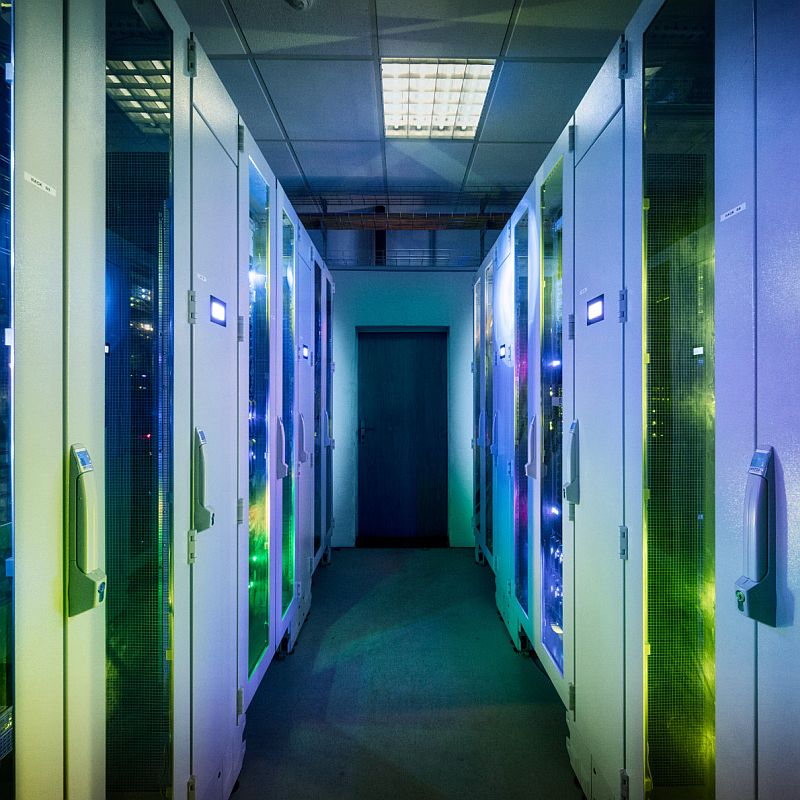Federal government supporting research project at the Software Innovation Campus Paderborn
Sustainable, high-level computing power thanks to wind energy
High-performance computing, or HPC, has become a key method in many scientific areas, including pharmaceutical and climate research. However, data centres with energy-intensive supercomputers produce quite a bit of CO2. ‘Energy-optimised supercomputer networks using wind energy’ (‘Energieoptimierte Supercomputer-Netzwerke durch die Nutzung von Windenergie’, ESN4NW) is the title of a new, nationwide joint project headed by the SICP – Software Innovation Campus Paderborn at Paderborn University. In collaboration with the SICP member company WestfalenWIND IT, the idea was born to develop new HPC infrastructure with a sustainable concept. The Federal Ministry of Education and Research (BMBF) is now funding the project for the next three years with a total of approximately 2.5 million euros. Other consortium members are the University of Passau, the Fraunhofer Institute for Reliability and Microintegration IZM, and the companies AixpertSoft GmbH, Rittal, Atos Deutschland and Zattoo.
New infrastructure with data centres in wind farms
The project’s partners are working together to research and demonstrate the potential of ‘windCORES’. These are wind turbines that house data centres within their towers, supplying them with locally produced, virtually climate-neutral wind power. The aim of the project is to develop the infrastructure and operations management for an HPC cluster within multiple wind turbines. Direct, locally available renewable energy should then be fed directly into operations management for maximum benefit. In addition, the resulting waste heat should be taken into account as a limiting factor.
To demonstrate, an alternative architecture approach going beyond the current state of the art will be pursued and implemented. The project partners are developing infrastructure that will continually adjust the local HPC cluster’s computing power via an operating platform thanks to intensive data use and artificial intelligence (AI) methods. The cluster will be split across multiple wind turbines and must make optimum use of volatile energy availability. Furthermore, the project will examine the impact of different architecture types and operating strategies on the target system’s sustainability rating. AI-supported operations management requires behaviour and predictive models for infrastructure and the local energy network, which do not yet exist. ‘The scientific and technical challenges of the project include intensive data acquisition and use (energy network and infrastructure), integrating artificial intelligence into control circuits, and systematically collating all models via a digital twin’, explains Dr. Gunnar Schomaker, manager at SICP. ‘Our focus will be on predicting weather-dependent local energy availability, as well as on precise behaviour models for all interdependent subsections in terms of their power draw and heat output’, Schomaker adds.
Innovative concept with intelligent circuitry
One particular, innovative feature of the project is the fact that the wind turbine tower can be used as a potential heat sink if there is no waste heat user or if the user does not need the waste heat at a given point. The tower can then absorb the waste heat from the IT systems and cool it down. Together with energy availability, this function will serve as guidance for operation of the HPC cluster. In specific terms, this means that the system will only run if renewable energy is available and waste heat can be discharged in virtually CO2 neutral form. Initially, the project will focus on technical and financial feasibility, a functional and didactic demonstration of the operations management, and the system’s sustainability rating during the extended system life cycle. However, the desired results are expected to be relevant not just to wind turbines, but also to other HPC systems with waste heat producers and users.
‘The project is focusing in particular on the challenges of the energy revolution and digitalisation. We want to show that the increasing energy requirements of digitalisation do not represent an impasse for increasing sustainability, and that this need for growth can also be covered by renewable energies both temporally and spatially’, as Dr. Fiete Dubberke, CEO of WestfalenWIND IT, explains the project’s objectives. ‘We are posing the following questions: How can we deal, i.e. use, waste heat from a wide range of industrial sectors? What user/producer systems are reasonably worth connecting and what tasks can incorporate artificial intelligence methods?’, Schomaker elaborates. The ‘windCORES’ concept, winner of the German Data Centre Award, has already shown that combining a wind turbine with a data centre can also be an economically successful prospect.
Last modified:
 Fraunhofer Institute for Reliability and Microintegration IZM
Fraunhofer Institute for Reliability and Microintegration IZM